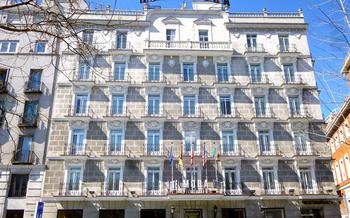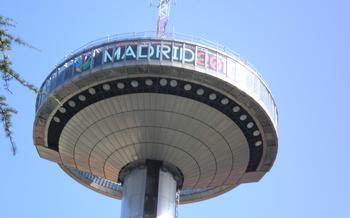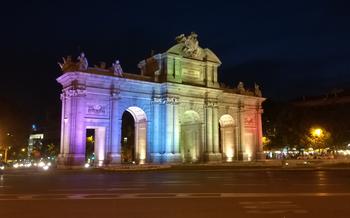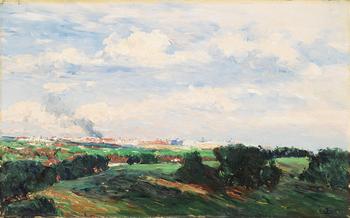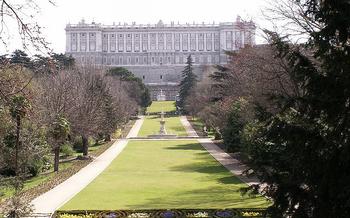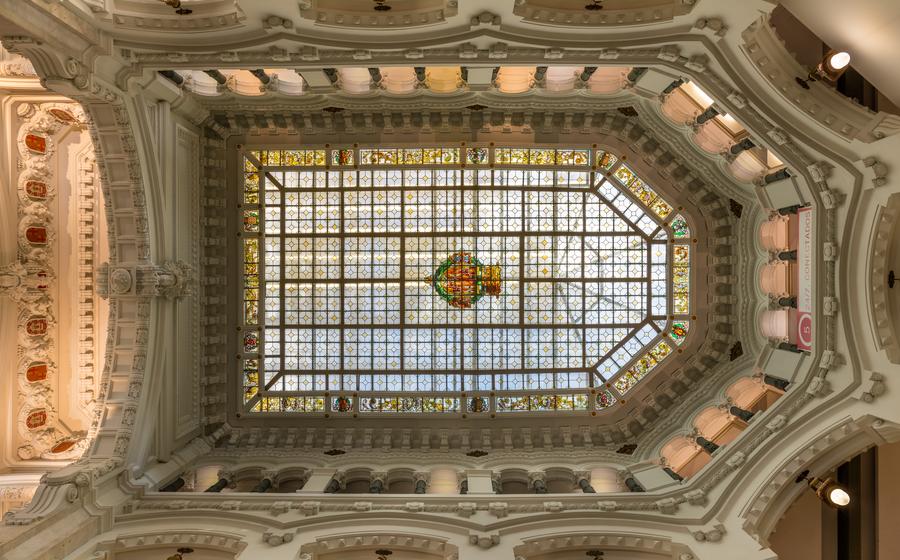
Palacio de Cibeles
- Historical significance
- Unveiling the Palacio's History: From Palace to City Hall
- Admire the City's Skyline from the Observation Deck
- Exploring the Palace's Exhibitions and Events
- Unveiling the Communications Museum
- Discover the Palace's Hidden Gardens
- Marvel at the City Hall's Hall of Plenary Sessions:
- Take Advantage of the Palacio's Tourist Information Center:
- Capture the Palace's Beauty Through Photography
- Indulge in Local Delicacies at the Palacio's Cafeteria
- Admire the Palacio's Lighting During Nighttime
- Learn About the Palacio's Role in Madrid's History
- Insider Tip: Take a Guided Tour for an In-Depth Experience
Historical significance
The Palacio de Cibeles holds a significant place in Madrid's history, serving as a testament to the city's transformation and growth. Constructed between 1904 and 1919, the palace initially served as the headquarters for the Correos y Telégrafos, the national postal and telegraph service. Its strategic location in the heart of Madrid, near the bustling Plaza de Cibeles, made it a hub for communication and connectivity. In 2007, the Palacio de Cibeles underwent extensive renovations to adapt to its new role as the seat of the Madrid City Council. This transition symbolized the building's evolving significance, transitioning from a symbol of communication to an emblem of civic governance. Today, the Palacio de Cibeles stands as a majestic landmark, embodying Madrid's rich history and its dynamic transformation into a modern metropolis.
Unveiling the Palacio's History: From Palace to City Hall
The Palacio de Cibeles holds a rich and storied history, transforming from a grand palace to the current seat of the Madrid City Council. Its origins trace back to 1904, the brainchild of architects Antonio Palacios impressive blend of Beaux-Arts and Neo-Gothic styles.
Over the years, the Palacio's functions evolved, mirroring the changing needs of the city. During the Spanish Civil War, it temporarily housed the Ministry of War. In 1968, the Madrid City Council purchased the building, transforming it into its new headquarters. This move marked a significant chapter in the Palacio's history, establishing it as a symbol of city governance.
Throughout its history, the Palacio has undergone several architectural transformations. In 1909, a fourth floor was added to accommodate the growing needs of the company. During the 1960s renovation, the interiors were modernized to meet the requirements of the City Council. The most striking transformation, however, occurred in 2007 when a glass dome was added to the building's central tower, creating a breathtaking observation deck that offers panoramic views of the city.
Admire the City's Skyline from the Observation Deck
Unparalleled Panoramic Views:
Soaring above the bustling city, the observation deck of the Palacio de Cibeles offers visitors an unparalleled panoramic vista of Madrid. This vantage point unveils a tapestry of iconic landmarks, including the majestic Royal Palace, the stately Almudena Cathedral, and the verdant expanse of Casa de Campo. The sweeping views stretch far beyond, encompassing the vibrant streets, lush parks, and distant mountains that define the cityscape.
Choosing the Perfect Moment:
To fully savor the spectacle, timing is everything. Ascend to the observation deck during the golden hour, when the setting sun casts a warm glow upon the city, painting the skyline with hues of amber and rose. Alternatively, visit at night, when Madrid transforms into a glittering constellation of lights, creating a magical panorama that will leave you spellbound.
Practical Information:
Before embarking on your ascent, be sure to check the operating hours of the observation deck, which may vary depending on the season. Admission fees are typically required, but discounts are often available for students, seniors, and families. For a truly immersive experience, consider joining a guided tour, which offers insights into the history and significance of the landmarks you'll encounter.
Exploring the Palace's Exhibitions and Events
The Palacio de Cibeles has been transformed into a vibrant cultural hub, hosting a variety of exhibitions and events that cater to diverse interests. The exhibitions showcase a diverse range of topics, from art and photography to history and science. Visitors can immerse themselves in the works of renowned artists, learn about the fascinating history of Madrid, or explore the wonders of the natural world.
The palace also hosts a variety of events, including concerts, conferences, and festivals. These events bring together people from all walks of life to celebrate culture, creativity, and community. From classical music performances to international conferences, there is always something exciting happening at the Palacio de Cibeles.
To make the most of your visit, check the palace's website or social media pages for the latest information on exhibitions and events. Here are some tips for visitors:
- Plan your visit in advance: Check the palace's website or social media pages for the latest information on exhibitions and events, and plan your visit accordingly.
- Arrive early for popular exhibitions: Some exhibitions may attract large crowds, so it's a good idea to arrive early to avoid long lines.
- Take your time: Allow yourself plenty of time to explore the exhibitions and events at your own pace.
- Don't forget your camera: The Palacio de Cibeles is a beautiful building, both inside and out, so don't forget to bring your camera to capture some memorable photos.
Unveiling the Communications Museum
Discover the History and Evolution of Communication:
Delve into the fascinating world of communication at the Communications Museum, housed within the Palacio de Cibeles. Established in 1920, the museum showcases the rich history and evolution of communication technologies, from ancient methods to modern-day advancements. Explore interactive exhibits, admire vintage artifacts, and learn about the pivotal role of communication in shaping societies throughout history.
Highlights of the Collection:
-
Ancient Communication Methods: Discover how early civilizations communicated through cave paintings, smoke signals, and messenger pigeons.
-
Telegraphy and Telephony: Witness the remarkable transformation brought about by the invention of the telegraph and telephone, enabling instant communication across vast distances.
-
Radio and Television: Trace the development of broadcasting and learn about the impact of radio and television on global communication.
-
Internet and Digital Technology: Explore the rise of the internet, the evolution of mobile communication, and the profound impact of digital technology on our lives.
Interactive Exhibits for an Immersive Experience:
Engage with the museum's interactive exhibits that bring communication history to life. Simulate a telegraph transmission, experience the thrill of early radio broadcasts, and dive into the virtual world of digital communication. These hands-on experiences make learning about communication both fun and memorable.
Discover the Palace's Hidden Gardens
Beyond its grand architecture and bustling halls, the Palacio de Cibeles holds a serene oasis within its premises: the hidden gardens. These enchanting green spaces offer visitors a tranquil retreat from the city's vibrant energy, allowing them to immerse themselves in the palace's natural beauty.
The history of the gardens dates back to the palace's construction in 191Originally designed as a private space for the Post Office's employees, the gardens were later opened to the public, becoming a popular spot for locals and tourists alike to escape the hustle and bustle of the city.
Unique features set the gardens apart from other green spaces in Madrid. Visitors can stroll along the meticulously manicured paths, admiring the colorful flowerbeds, vibrant shrubs, and towering trees that create a sense of tranquility. The gardens are also home to a variety of sculptures, fountains, and ponds, adding to their charm and elegance.
Guided tours of the gardens are available, providing visitors with an in-depth understanding of their history, design, and significance. These tours offer a unique opportunity to learn about the palace's horticultural heritage and the role of the gardens in the larger context of Madrid's urban landscape.
Marvel at the City Hall's Hall of Plenary Sessions:
The Hall of Plenary Sessions is the heart of the Palacio de Cibeles, where the Madrid City Council meets to discuss and decide on matters that affect the city. This impressive chamber is adorned with a majestic ceiling mural depicting scenes from Madrid's history, intricate stained-glass windows that filter in colorful light, and elegant chandeliers that illuminate the proceedings.
History of the Hall:
The Hall of Plenary Sessions was constructed in 1919 as part of the original design of the Palacio de Comunicaciones. It was designed to be a grand and imposing space, reflecting the importance of the city council and its role in governing Madrid. The hall has undergone several renovations over the years, but its original grandeur remains intact.
Architectural Highlights:
The semicircular layout of the hall allows for optimal acoustics and facilitates open dialogue among the council members. The raised platform at the front of the chamber is reserved for the mayor, the city council president, and other dignitaries. The marble flooring, rich wood paneling, and ornate ceiling moldings create a sense of solemnity and importance.
Role in City Governance:
The Hall of Plenary Sessions is where the most important decisions regarding Madrid's governance are made. The city council meets regularly to discuss and vote on budgets, urban planning, environmental regulations, and other issues that impact the lives of Madrid's citizens. The public is welcome to attend these meetings and observe the proceedings.
Interesting Fact:
The Hall of Plenary Sessions was the setting for the historic signing of the Madrid Accords in 1975, which led to the end of the Franco regime and the transition to democracy in Spain. This event marked a turning point in Madrid's history and solidified the city's role as a center of political power and progress.
Take Advantage of the Palacio's Tourist Information Center:
The tourist information center at the Palacio de Cibeles is a valuable resource for travelers seeking to make the most of their visit to Madrid. Located in the heart of the city, this center offers a wealth of services to assist visitors in planning their itinerary and exploring the city's attractions.
Services offered:
- Information Desks: Approachable and knowledgeable staff members are available to answer questions, provide advice, and offer personalized recommendations based on your interests and preferences.
- Maps and Brochures: A comprehensive selection of maps, brochures, and guides to Madrid and its surrounding areas is available for free, helping you navigate the city with ease.
- Multi-lingual Assistance: The center's multilingual staff ensures that visitors from all over the world can receive assistance in their preferred language, making it easy to communicate and understand the information provided.
- Ticket Reservations: For those wishing to visit popular attractions or events, the center offers a convenient ticket reservation service, allowing you to secure your tickets in advance and avoid long queues.
- Cultural Events and Tours: Information on upcoming cultural events, exhibitions, and tours is available, helping you discover the vibrant cultural scene of Madrid and plan your visit accordingly.
Capture the Palace's Beauty Through Photography
Immerse yourself in the art of photography and capture the essence of the Palacio de Cibeles. With its stunning architecture and iconic location, the palace offers endless opportunities for photography enthusiasts. Whether you're a seasoned professional or just starting, here are some tips to help you create memorable shots:
-
Choose the Right Angle: Experiment with different angles to find the perfect perspective. The palace's grand facade is best captured from a distance, while close-up shots can highlight intricate details and sculptures.
-
Play with Light: The changing light throughout the day creates different moods and atmospheres. Early morning and late afternoon light casts a warm glow on the palace, while night photography allows you to capture the illuminated facade against the dark sky.
-
Use a Tripod: A tripod will help you stabilize your camera and avoid blurry images, especially when shooting in low-light conditions or using a telephoto lens.
-
Capture the Details: Don't just focus on the overall structure; take time to capture the intricate details, such as the sculptures, carvings, and stained-glass windows. These details add depth and character to your photographs.
-
Be Respectful: Remember that the Palacio de Cibeles is a public building and respect the privacy of others. Be mindful of people passing by and avoid using flash photography inside the palace.
Indulge in Local Delicacies at the Palacio's Cafeteria
After exploring the Palacio de Cibeles's architectural wonders and exhibitions, take a break and savor the flavors of Madrid at the palace's charming cafeteria. Located on the ground floor, the cafeteria offers a delightful menu featuring a range of local delicacies and international favorites.
Indulge in traditional Spanish tapas, such as the classic tortilla de patatas (potato omelet) or croquetas de jamón (ham croquettes). Sample regional specialties like cocido madrileño, a hearty stew made with chickpeas, meats, and vegetables. For a lighter option, opt for a fresh salad or a selection of cheeses and cured meats.
Don't miss the opportunity to try the cafeteria's signature dish, the "Bocadillo de Calamares" (squid sandwich). This beloved Madrilenian snack consists of crispy fried squid served in a soft bun, often accompanied by aioli sauce.
Relax in the cafeteria's inviting atmosphere, characterized by its elegant décor and large windows that flood the space with natural light. Enjoy your meal while admiring views of the city's bustling streets and the iconic Cibeles Fountain.
The cafeteria also offers a variety of drinks, including coffee, tea, juices, and alcoholic beverages. Whether you're looking for a quick bite or a leisurely lunch, the Palacio de Cibeles cafeteria is the perfect spot to savor Madrid's culinary delights while immersing yourself in the palace's grandeur.
Admire the Palacio's Lighting During Nighttime
As darkness envelops Madrid, the Palacio de Cibeles transforms into a mesmerizing beacon of light. The building's stately facade is adorned with thousands of LED bulbs that illuminate its intricate architectural details, casting a warm glow that radiates across the city's skyline. The effect is truly awe-inspiring, creating a magical and unforgettable sight.
During the festive season, the Palacio's lighting takes on a special charm. The facade is adorned with colorful Christmas lights, twinkling stars, and festive motifs, transforming the building into a symbol of joy and cheer. The surrounding streets and plazas are also illuminated, creating a vibrant and enchanting atmosphere that draws locals and visitors alike.
Whether you're admiring the Palacio's nighttime illumination from afar or strolling through the illuminated streets, the experience is sure to leave a lasting impression. Be sure to capture this magical moment with your camera, as the Palacio's nighttime beauty is a sight to behold.
Learn About the Palacio's Role in Madrid's History
The Palacio de Cibeles has witnessed and played a pivotal role in Madrid's rich and vibrant history. It stands as a silent sentinel, bearing witness to the city's triumphs, struggles, and transformations. During the Spanish Civil War, the palace served as the headquarters of the Republican government, making it a target for aerial bombardments. The scars of these attacks are still visible on the building's facade, serving as a poignant reminder of Madrid's resilience in the face of adversity.
The palace's history is intertwined with that of the city itself. It has served as a venue for countless political rallies, cultural events, and international summits. Within its walls, decisions that shaped the course of Madrid's development were made, and agreements that fostered cooperation and understanding between nations were signed. The palace has also been a witness to moments of great joy and celebration, such as the city's victory in its bid to host the 1982 FIFA World Cup.
Local legends and stories abound, adding to the allure of the Palacio de Cibeles. One such tale speaks of a secret tunnel that connects the palace to the nearby Retiro Park, allowing for discreet movement between the two locations. Another legend tells of a hidden treasure buried beneath the palace, waiting to be discovered by a lucky individual. Whether these stories are true or not, they contribute to the mystique and fascination surrounding this iconic landmark.
Insider Tip: Take a Guided Tour for an In-Depth Experience
To gain a deeper understanding of the Palacio de Cibeles and its significance, consider joining a guided tour. Led by knowledgeable experts, these tours offer an immersive experience that unveils the palace's hidden stories, architectural nuances, and intriguing past. Choose from various tour options that cater to different interests, whether you're an architecture enthusiast, history buff, or simply curious about the building's transformation over the years.
Guided tours often provide exclusive access to restricted areas, allowing visitors to explore the palace's hidden corners and secret passageways. They also offer insights into the palace's role in shaping Madrid's history, shedding light on its involvement in pivotal events and its influence on the city's development. By participating in a guided tour, you'll gain a newfound appreciation for the Palacio de Cibeles, leaving you with a lasting impression of its grandeur and historical importance.


